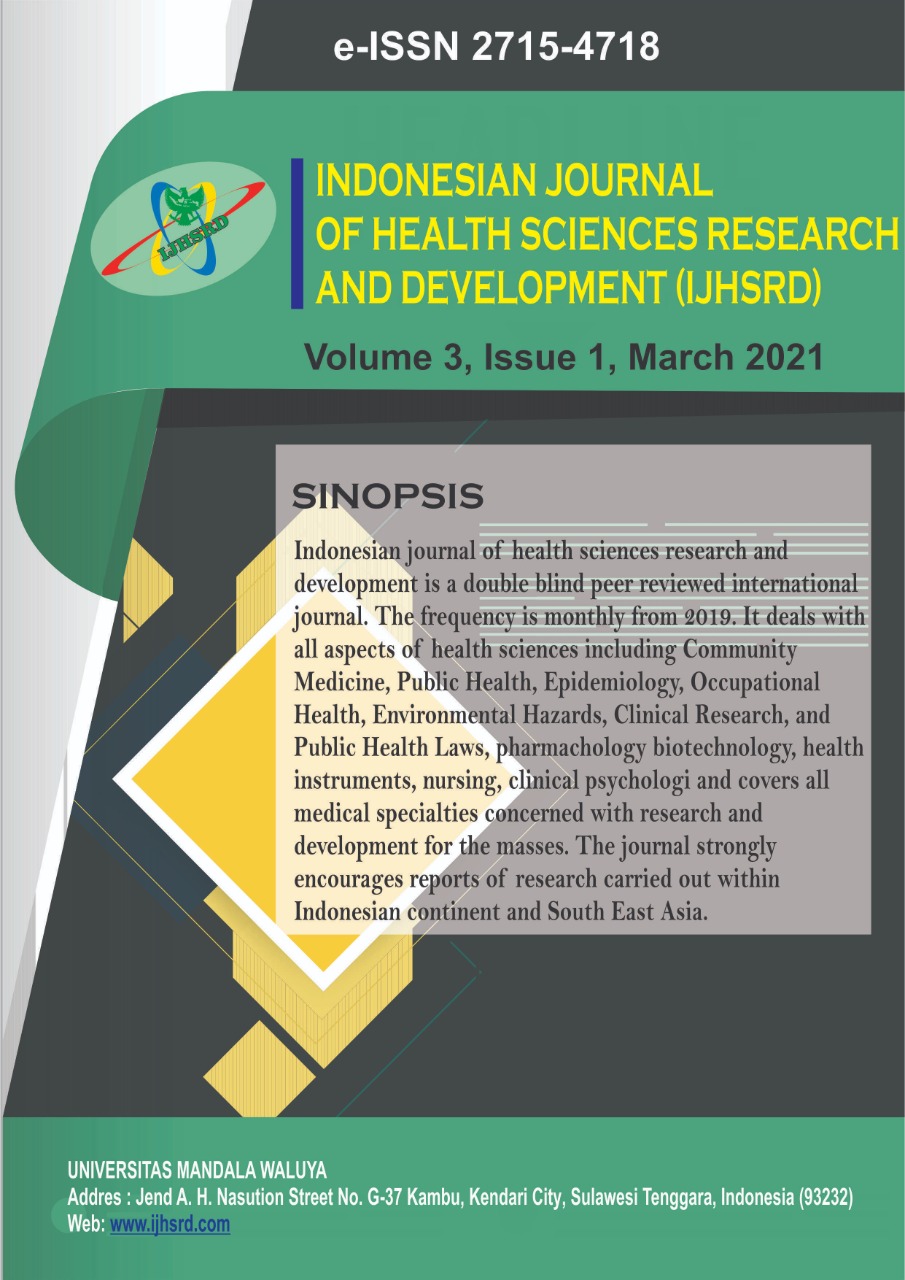Main Article Content
Abstract
Background: The cases of Covid-19 disease continue to rise in Kendari city, Southeast Sulawesi Province, Indonesia. In 2020, the task force of Covid-19 cases reported there were about 3,736 people who got Covid-19 diseases in Southeast Sulawesi Province.To reduce the cases, the Indonesian government have prepared some of covid-19 vaccines. However, the majority of community in this Province are still hesitant to accept covid-19 vaccines. Therefore, this study aimed to understand the relationship between demographic factors and individual perception about covid-19 vaccines surrounding people in Southeast Sulawesi Province.
Methods: This study was conducted since January 2020 until October 2020 in Southeast Sulawesi Province of Indonesia. This study recruited 210 respondents with 95% of interval confidence. Dependent variables were demographic factors which comprised age, sex, educational status, mariage status and occupation. Independent variable was individual perception about covid-19 vaccines. Data collection used Google form which was sent through WhattsApp of social media. Statistical analysis used chi-square test and Cramer’s test to understand significant association.
Results: This study showed Sex had significant association with individual perception about covid-19 vaccines (P value=0.041<0.05; Cramer’s value=0.174). However, age, educational status, mariage status, and occupation were not associated significantly with the individual perception about covid-19 vaccines. Female had better perception than male about covid-19 vaccines.
Conclusions: This study shows that female have more information than male about covid-19 vaccines. This is caused by several media to get information including female organizations in the village such as women organization, islamic women organization and social media groups. Women is more communicative than male.
Keywords
Article Details

This work is licensed under a Creative Commons Attribution-ShareAlike 4.0 International License.
References
- Yuan, Z., Xiao, Y., Dai, Z., Huang, J., Zhang, Z., & Chen Y. Modelling the effects of Wuhan’s lockdown during Covid-19, China. Bull World Heal Organ. 2020;98(7):484–94.
- World Health Organization. WHO Coronavirus Disease (COVID-19). Geneva: World Health Organization; 2020.
- World Health Organization. Medical certification, ICD mortality coding, and reporting mortality associated with Covid-19. Geneva: World Health Organization; 2020.
- Task force for Covid-19 treatment. Distribution of Covid-19 cases in Indonesia [Internet]. Task force for Covid-19 treatment, Indonesia. 2020 [cited 2020 Oct 14]. Available from: https://covid19.go.id/peta-sebaran
- Southeast Sulawesi Province Agency of Statistic Center. Southeast Sulawesi Province in 2020. Kendari: Southeast Sulawesi Province Agency of Statistic Center; 2020.
- World Health Organization. Draft landscape of Covid-19 candidate vaccines. Geneva: World Health Organization; 2020.
- Health Ministry of Republic of Indonesia. Regulation of Health Ministry of Republic of Indonesia Number HK.01.07/MENKES/9860/2020 about Types of vaccines to Corona Virus Disease 2019 (COVID-19) vaccination Program. Jakarta: Health Ministry of Republic of Indonesia; 2020.
- President of Republic of Indonesia. President Regulation of Republic of Indonesia [Internet]. Jakarta: Ministry of Law & Human Right of Republic of Indonesia; 2017. Available from: http://gurudesa.com/wp-content/uploads/2018/10/PERPRES_NO_99_2017.pdf
- Tononi G. Information integration: its relevance to brain functionn and consciousness. Arch Ital Biol. 2010;148:299–322.
- Sari, R. A. Students’ perceptions on the video project in their speaking class: A study of 11th grade of SMAN 1 Kasian Students [Internet]. Sanata Dharma University; 2016. Available from: https://repository.usd.ac.id/7303/2/121214043_full.pdf
- Ramadhani, Y. R., Masrul, Ramadhani R, Rahim R, Tamrin AF, Daulay JS, et al. Methode and Technique in Inovative learning. Medan, Indonesia: Yayasan Kita Menulis; 2020.
- Brandley KS, Brandley, J. A. Teaching students to organize and synthesize information. J Int Assoc Spec Eduation. 2006;7(1):75–9.
- Davis B, Summers, M. Applying Dale’s Cone of Ecperience to increase learning and retention: A study of student learning in a foundational leadership course. West Lafayette, USA: Purdue University; 2015.
- Kuhn D, Siegler, R. S. Handbook of child psychology: Cognition, perception, and language. New Jersey: John Wiley & Sons; 2006. 138 p.
- Padmawati, R. S, Heywood A, Sitaresmi MN, Atthobari J, Macintyre CR, Soenarto Y, et al. Religious and community leaders’ acceptance of rotavirus vaccine introduction in Yogyakarta, Indonesia: A qualitative study. BMC Public Health. 2019;19(368):1–6.
